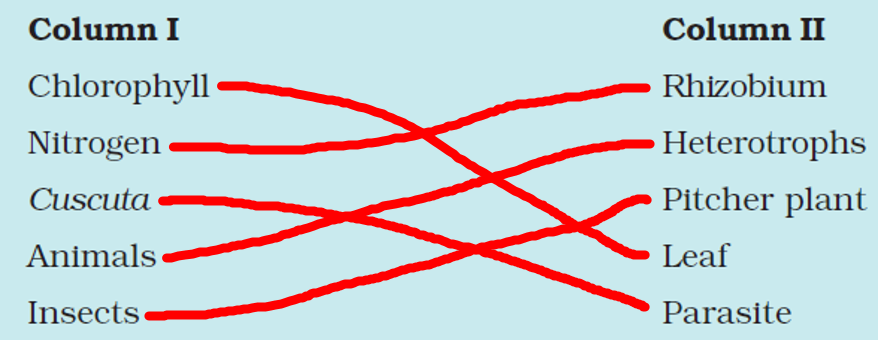Chapter 1 - Nutrition in Plants
Question 1: Why do organisms need to take food?
Answer: All organisms need to take in food because they utilize food to get energy for their growth and maintenance of their body.
Question 2: Distinguish between a parasite and a saprotroph.
Answer:
Parasite: The plant which deprives the host for valuable nutrients is called parasite.
Saprotroph: The organisms which convert the dead and decaying matter into a solution by using digestive juices are called saprotroph.
Question 3: How would you test the presence of starch in leaves?
Answer: Take a fresh leaf; boil the leaf in water for some time to soften the cells of leaf. Now put 2-3 drops of iodine solution on that leaf. If the color of the leaf changes to blue-black color then the leaf shows the presence of starch in it.
Question 4: Give a brief description of the process of synthesis of food in green plants.
Answer: The process of synthesis of food in green plants is called photosynthesis. This process takes place in the cells containing chlorophyll. The plant use carbon-dioxide (CO₂) and water (H₂O) to synthesis carbohydrates.
Question 5: Show with the help of a sketch that the plants are ultimate source of food.
Answer:
Question 6: Fill in the blanks:
a) Green plants are called _________ since they synthesize their own food.
b) The food synthesised by the plants is stored as ________.
c) In photosynthesis solar energy is captured by the pigment called _________.
d) During photosynthesis, plants take in _______________ and release __________.
Answer:
a) Green plants are called autotrophs since they synthesize their own food.
b) The food synthesised by the plants is stored as starch.
c) In photosynthesis solar energy is captured by the pigment called chlorophyll.
d) During photosynthesis, plants take in carbon-dioxide and release oxygen.
Question 7: Name the following
i) A parasite plant with yellow, slender and tubular stem.
Answer: Amarbel
ii) A plant that has both autotrophic and heterotrophic mode of nutrition.
Answer: Pitcher plant
iii) The pores through which leaves exchange gases.
Answer: Stomata
Question 8: Tick the correct answer:
a) Amarbel is an example of
i) Autotrophs
ii) Parasite
iii) Saprotrophs
iv) Host
Answer: ii) Parasite
b) The plant which traps and feeds on insect is
i) Cuscuta
ii) China rose
iii) Pitcher plant
iv) Rose
Answer: iii) Pitcher plant
Question 9: Match the items given in Column I with those in Column II:

Answer:

ii) Plants which synthesise their food are called saprotrophs. (T/F)
iii) The product of photosynthesis is not a protein. (T/F)
iv) Solar energy is converted into chemical energy during photosynthesis. (T/F)
Answer:
i) False
ii) False
iii) True
iv) True
Question 11: Choose the correct option from the following:
Which part of the plant takes in carbon dioxide from the air for photosynthesis?
i) Root hair
ii) Stomata
iii) Leaf veins
iv) Petals
Answer: ii) Stomata
Question 12: Choose the correct option from the following:
Plants take carbon dioxide from the atmosphere mainly through their:
i) roots
ii) stem
iii) flowers
iv) leaves
Answer: iv) leaves
Question 13: Why do farmers grow many fruits and vegetable crops inside large green houses? What are the advantages to the farmers?
Answer: Fruits and vegetable crops are grown in large greenhouses because it protects crops from the external climatic condition and provides suitable temperature for the growth of crops. Advantages to farmers while growing fruits and vegetable crops inside greenhouses are:
• It protects crops from diseases and adverse climatic conditions
• It protects crops from wind and rodents
• Farmer's crops are also protected from birds and animals.
No comments:
Post a Comment